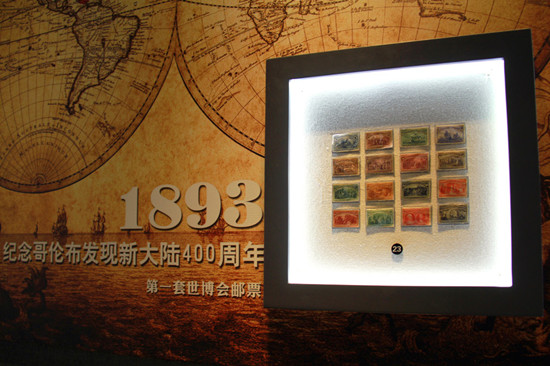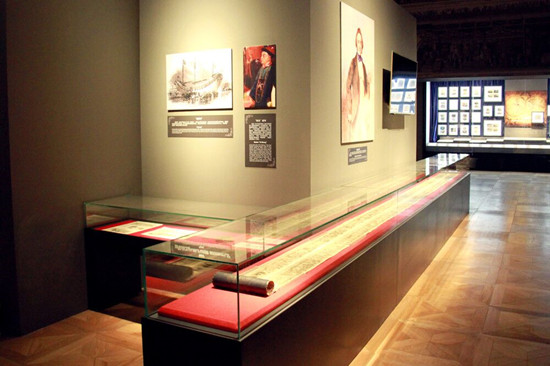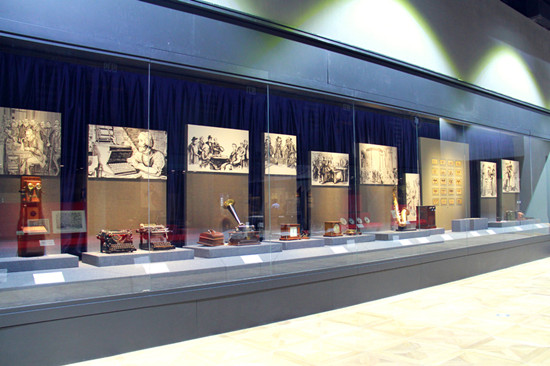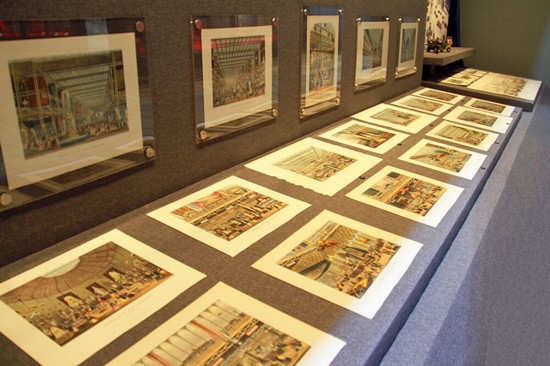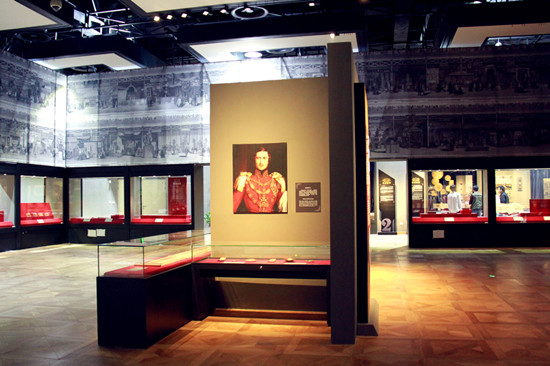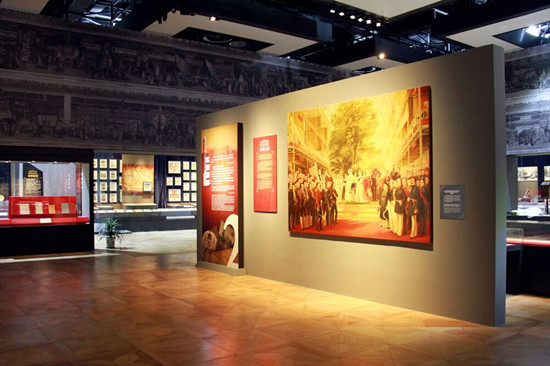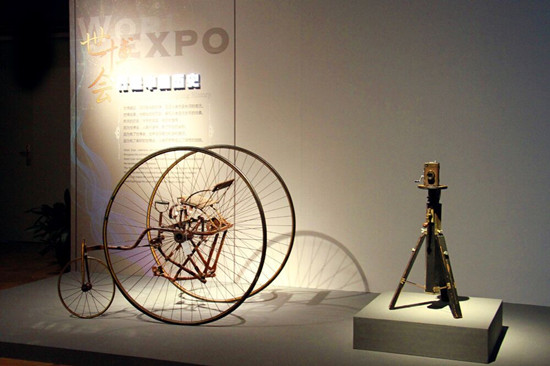Expo Heritage: Exhibits Collection from World Expos
The Expo Heritage exhibition is the first special exhibition planned by World Expo Museum. The exhibition will last for more than half a year and will be closed in early 2019. The exhibition mainly includes physical exhibits while multimedia exhibits make the exhibition more exciting. For the first time, the exhibition presents more than 600 pieces (or sets) of legacy objects of World Expos, including medals, prints, porcelainproducts, stamps and documents.
The exhibition classifies the Expo legacy exhibits into series, highlighting Expo personnel and Expo stories, and present them in two sections: History of World Expos and Legacies of World Expos, showing the essence and charm of World Expos. The History of World Expos section is subdivided into five modules, namely Expo Medals, Expo Prints, Expo Stamps, Expo Porcelain and Expo Creation. The Legacies of World Expos has two parts: Early World Expos and A Glimpse of China. As a themed exhibition on World Expos, this special exhibition tells the story of the first World Expo in 1851 and the early participation in World Expos.
Highlights
1.Medal Set, World Expo 1873 Vienna,Austria
Diameter 7 cm, thickness 0.5 cm, weight 138 gm, 145 gm, 147 gm, 127gm, 147 gm, bronze, original box
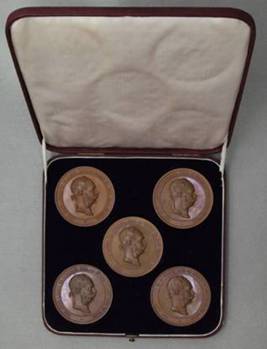
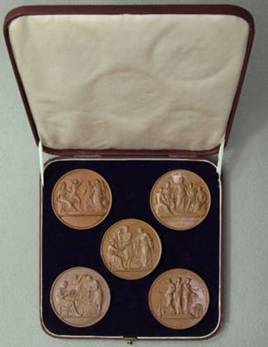
The 25th anniversary of Austro-Hungarian Empire’s emperor, Josef’s coronation was in 1873. To improve the image of the Austro-Hungarian Empire, showcase its strength and remarkable achievements to the world, and raise the country’s status, the Austro-Hungarian Empire held the Weltausstellung 1873 Wien (World Exposition 1873 Vienna). This was the first time World Expo to be held in a German-speaking country.
This medal set consists of five medals. On the obverse of each medal there is a portrait of Franz Josef, Emperor of Austro-Hungarian Empire, and it is surrounded by an inscription in Latin,"FRANZ JOSEPH I KAISAR VON OESTERREICH. KOENIG VON BOEHMEN ETC. APOST. KOENIG VON UNGARN", which means "Franz Joseph I, Emperor of Austro-Hungarian Empire". Below the portrait,"J TAUTENHAYN", en abbreviation of the sculptor’s name Joseph Tauntenhayn is inscribed.
On the reverse, there is a scene depicting characters dressed in classical costumes, holding laurel wreaths and awarding prizes. The text around the scene is inscribed in Latin "WELTAUSSTELLUNG 1873 WIEN", meaning World Exposition 1873 Vienna. The small letters on the lower left side of the scene are an abbreviation of the sculptor’s name.
2. Medal set, World Expo 1904 Louisiana St. Louis, USA
7.4 × 6.5cm, thickness 0.5cm, weight 147g, bronze, the original box
7.1 × 7.1cm, thickness 0.5cm, weight 144g, bronze, the original box
6.7 × 6.7cm, thickness 0.5cm, weight 167g, bronze, the original box
Diameter 6.4, thickness 0.4cm, weight 108g, bronze, the original box
7.1 × 7.1cm, thickness 0.5cm, weight 142g, bronze, the original box
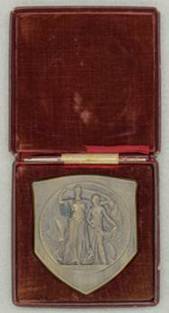
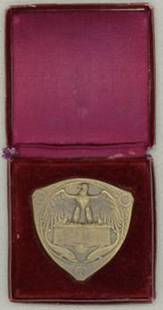
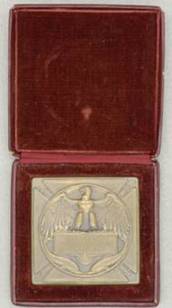

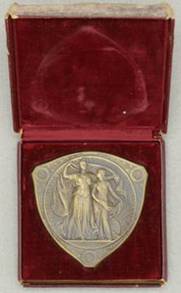
In 1904, to commemorate the 100th anniversary of the purchase of Louisiana and to showcase a century’s progress, the United States decided to hold the World Expo in Saint Louis. This was also the second time that a World Expo was held at the same time as the Olympic Games.
This is a complete St. Louis World Expo medal set, and includes five medals, all designed by Adolph Alexander Weinman (1870-1952). Since this World Expo, World Expo medals were divided into gold, silver and bronze, and World Expo medals in other shapes were rewarded for the first time. The grand prize of this World Expo medals in other shapes were awarded for the first time. This World Expo’s grand prize was a pentagon-shaped shield, the gold medal and commemorative medal were triangular-shaped shields, the silver medal was square and the bronze medals was round in shape. The round designs in the center on the obverse and reverse of all the medals are the same, except for the English words “GRAND PRIZE”,“GOLD MEDAL”,“SILVER MEDAL”,"BRONZE MEDAL" and "COMMEMORATIVE MEDAL” on different medal grades.
There are two women depicted on the obverse. The tall woman representing United States, who is holding USA’s national flag, is spreading her arms to welcome the short woman representing Louisiana, who is removing the French cloak, to join the United States. A red sun is rising behind them, symbolizing a new period of development for the United States. Surrounding them is the English inscription "UNIVERSAL EXPOSITION-SAINT LOUIS-UNITED STATES OF AMERICA", which means "World Expo St. Louis, USA". The Bald Eagle with outspread wings at the top of the medal’s reverse is the national bird and symbol of the United States. Below it, it is the medal grade and the words “LOUISIANA PURCHASE EXPOSITION” inscribed in English. The two dolphins symbolize the east and west boundaries of the United States: the Atlantic and the Pacific. The medals are all made of bronze alloy and cast by the National Mint in Philadelphia.
3.Commemorative Stamp, World Expo 1893 Chicago, USA
Set of 16 single stamps, 40×28 mm

In 1893,the United States hosted the World’s Columbian Exposition at Chicago to commemorate the 400th anniversary of Columbus’ discovery of the New World. This was the largest World Expo with the most exhibits held till that date by the United States in the 19th century.
On January 2nd 1893, the Postal Department of the United States specially issued a 16-piece set of commemorative stamps titled The 400th Anniversary of Columbus’s Discovery of the Americas. It is the first set of commemorative stamps on World Expo to be issued anywhere in the world. All the images are taken from world famous paintings collected in Spanish and Italian museums. The pictures on the stamps show “Columbus in Sight of Land”,“The Landing of Columbus”,“Flagship of Columbus”,“Fleet of Columbus”,“Columbus Soliciting Aid if Isabella”,“Columbus Welcomed at Barcelona”,“Columbus Restored to Favor”,“Columbus Presenting Natives”,“Columbus Describing his Discovery”,“Columbus at La Rabida”,“Recall of Columbus”,“Isabella Pledging her Jewels”,“Columbus in Chains”,“Columbus Describing Third Voyage”,“Isabella and Columbus” and “Columbus”(portrait).
4.Porcelain set, World Expo 1904 St. Louis, USA
Plate (left) diameter 13.6 cm, height 2.7 cm, weight 127 gm
Plate (right) diameter 15.7 cm, height 2 cm, weight 158 gm
Teacup with handle (left) 10.8×8×5.4 cm,weight 88 gm
Teacup with handle (middle) 6.8×5.5×5.5 cm,weight 42 gm
Teacup with handle (right) 9×6×5.8 cm,weight 54 gm
Cup (left) 6.7×6.7×9.3 cm, weight 137 gm
Cup (right) 6.7×6.7×9.3 cm, weight 137 gm
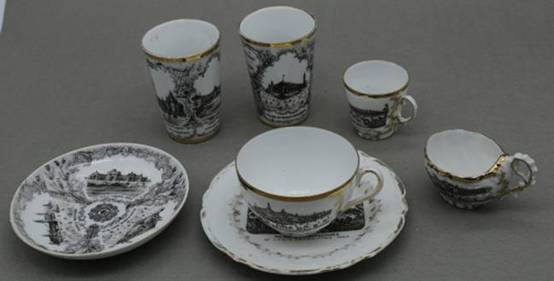
This is a 7-piece set, consisting of 2 porcelain plates and 5 porcelain cups, all inlaid with golden edges and decorated with the pattern of this World Expo pavilion.
The World Expo covered a total area of 5 million square meters. It consisted of two parts, St. Louis Forest Park and the University of Washington campus. The Expo had a total of eight theme pavilions, namely, the production pavilion, the electrics pavilion, the machine pavilion, the transport pavilion, the comprehensive industry pavilion, the education and sociology pavilion, the mineral and metallurgy pavilion and the arts and sciences pavilions.
5.Cabinet Stereo viewer
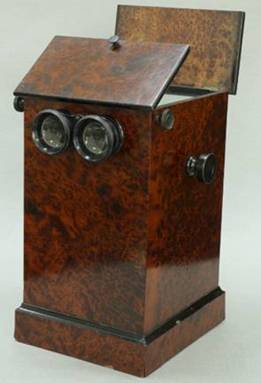
Emerging in the 1850s, stereo photographs began to prevail since World Expo 1851 London UK. The pictures, which were taken with the special twin-lens, required particular viewers. The stereoscopic effect resulted from the parallax between the eyes, with the same imaging principle as the present VR technology.
This Stereo viewer dates back to the 1870s.
6.Graphophone Phonograph
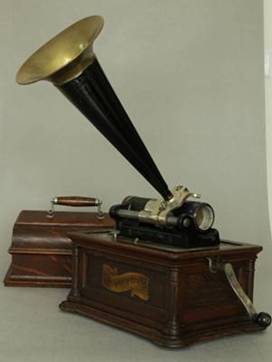
The phonograph, which later came to be known as the gramophone, was a sound recording and playing device invented by the American inventor Thomas Alva Edison. In 1877, the 30-year-old Edison successfully conducted his “sound capture test”. He played back his own voice recorded on a “tinfoil cylinder phonograph”, and this marked the beginning for humans to record and replay sounds. Edison exhibited his phonograph at the 1878 Exposition Universelle in Paris, France. However, Edison’s phonograph was not put into use on a large scale at that time for various reasons such as inferior sound effect, unclear voices loud noises and high cost.
This began to change in 1886, Chichester Bell and Charles Summer Tainter from Volta Laboratory patented the wax-coated vertical hill-and-dale groove recording system. They called their device the Graphophone. In1887, Emile Berliner patented the Gramophone.
This gramophone is marked with the trademark “Columbia Graphophone” on the carton. It’s a graphophone produced by the renowned Columbia Graphophone Company, which produced gramophones, disc gramophones with external speakers and disc gramophones with internal speakers.
The wooden base is clearly marked with a yellow logo, with the words inscribed in English “Graphophone and Columbia records were awarded the grand prize at the Paris exposition 1900 and St. Louis exposition 1904”.
7.Oil Painting Depicting World Expo 1851 London UK, The Opening of World Expo by Queen Victoria on 1 May 1851 (replica)

The original piece was painted by Henry Courtney Selous(1803-1890) and collected by the Victoria and Albert Museum in London. It depicted the spectacle of The Queen of England meeting the envoys of various countries at the opening ceremony of World Expo 1851.
8.Panorama, World Expo 1851 London, UK
Wood Engraver, black and white, 674 × 28 cm
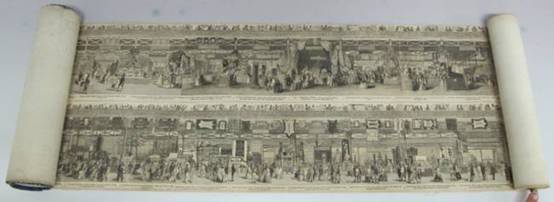
This item is a printed scroll made by Illustrated London News, an old British Illustrated newspaper, to commemorate the World Expo of 1851, which was held in London. The scroll header is engraved with the crown and the caption "Illustrated London News, Panorama of Great Exhibition of the Works of Industry of all Nations".
The picture in the scroll is a painting based on a silver daguerrotype taken by Richard Beard at the site and reproduced by Wood Engraver, a technique that flourished in the West in the 19th century. Pictures made by this technique appears like photographs, but traces of the woodcut stitch are visible because more than one wooden block are used.
The first image in the scroll is a chart showing the number of visitors during the World Expo. The other images depict the scenes and exhibits of the various pavilions within the Crystal Palace.
9.Official Reports and Catalogue of World Expo 1851 London, UK
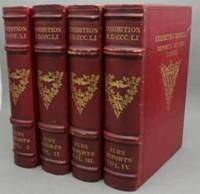


The report involves 154 original photos and was printed for 130 sets which used to be only available for the exhibitors, the royals and the celebrities rather than for sale. The sumptuous series of 4 reports serves as official literature of the World Expo that integrates research and collection values.
The exhibitor directory bears 398 illustrations and the layout of the venue. The three thick volumes serve as an official literature of the World Expo that integrates research and collection values.
The sumptuous single volume serves as an official literature of the World Expo that integrates research and collection values.
10.Copper Wine Warmer Made in Shanghai China, World Expo 1900 Paris, France
42×19×13.2cm

This is a double-cup copper wine warmer from Late Qing dynasty, and has a unique shape and refined craftsmanship. The kettle is attached with an exhibitor’s label, and the French inscription on it means 1900 World Expo Paris, China (Class XI, subclass 65, exhibitor: Chinese government; origin: Shanghai; serial number 87; price: 10.00). It also has the symbol of the yellow dragon flag representing the Qing Empire. It’s a Chinese exhibit, which was showcased at the 1900 World Expo in Paris, France.
11.Canned Tea Made in Zhejiang China, World Expo 1915 San Francisco, USA

11×11×14 cm
At the 1915 Panama-Pacific International Exposition in San Francisco, USA, the newly founded ROC government established the Ministry of Commerce and Industry to handle affairs for this event. Further, they specially established the Preparatory Office for Panama Games, and corresponding export associations for Panama Games in all provinces, to formulate regulations and collect articles for the Expo.
Chinese exhibits were displayed in 8 professional pavilions and the China Pavilion. Exhibits in the Agriculture Pavilion were mainly tea leaves. Chinese tea made great strides at this World Expo, winning a total of 44 prizes, namely 7 grand medals, 6 honor medals, 21 gold medals, 4 silver medals, 1 bronze medal and 5 award plaques. Among them, Dongyang tea leaves, the winner of the gold medal on behalf of Zhejiang, was made in Dongxiang (present-day Weishan).
This tea can was an exhibit at the 1915 Panama-Pacific International Exposition. The label on the can reads “made in Dongyang Country, Zhejiang Province, the Republic of China”, and the English label reads “Panama-Pacific Exposition San Francisco 1915”. The English label of US Customs on the bottom reads “U.S. Customs Panama-Pacific International Exposition Exhibit; Serial No.730, Case No.126”.
